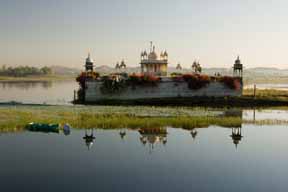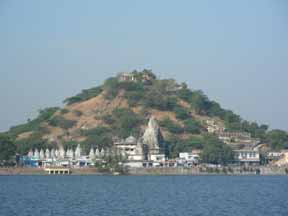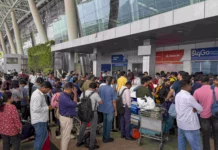Famous for its unique style of architecture
 Dungarpur is a small city located in the western Indian state of Rajasthan and is famous for its temples and palaces. The district of Dungarpur extends from latitude 23°50′ in the north to longitude 73°50′ in the east. There is a good road network that connects Dungarpur to other cities in Rajasthan.
Dungarpur is a small city located in the western Indian state of Rajasthan and is famous for its temples and palaces. The district of Dungarpur extends from latitude 23°50′ in the north to longitude 73°50′ in the east. There is a good road network that connects Dungarpur to other cities in Rajasthan.
Like most other places in north India, the climate of Dungarpur is tropical with not much rain during the monsoon. Average temperature during the summer hovers around 40°C and during winters, it remains close to 10°C. Best time to visit October to February.
History: The district is named after the capital of the former princely state of Dungarpur. Dungar means a hill or a mountain and pur means a town, thus Dungarpur means a ‘hill-town’.
Rawal Veer Singh Dev took over this part of the state from the Bhil Chieftain Dungaria and laid the foundation of the city as well as of the Old Palace on October 14, 1282 AD.
Dungarpur is famous for its unique style of architecture. The palaces of the Dungarpur princes and the residences of the noblemen are adorned by a new style of jharokhas, which were developed during Maha Rawal Shiv Singh’s reign (AD 1730-1785). The gold and silversmiths of Dungarpur and Banswara are well known for their lacquer painted toys and picture framing.
 Tourist attractions:
Tourist attractions:
Nestled in the foothills of the Aravalis, Dungarpur has an interesting topography, ranging from wild and rugged terrain in the northeast to fertile plains of alluvial soil in the southwest. Two magnificent rivers –
the Mahi and the Som flow through the area. While the former separates the district from Banswara, the latter draws a natural boundary between the district and Udaipur.
The area is rich in teak, mahua, mango and khajur trees. Dungarpur is also noted for its wildlife variety – jackal, jungle cat, Indian fox, hyena, black-faced monkey, porcupine, common mongoose are the common inhabitants. The commonly seen bird variety includes partridges, peafowls, quails, cuckoos, eagles and vultures. Various migratory birds also visit the area during the winters.
The Udai Bilas Palace was the royal residence named after Maha Rawal Udai Singh II, a patron of art and architecture. The palace is an example of the Rajput architecture characterized by intricately sculptured pillars and panels, impressive balconies, bracketed windows, and marvelous arches.
The Juna Mahal is a 13th century seven storied structure resembling a fortress with walls, turrets, narrow entrances and corridors to slow down the enemy. The splendid interiors embellished with beautiful frescoes, miniature paintings and glass and mirror work make it an impressive creation.
A famous shrine of Shri Nathji lies along the Gaib Sagar Lake. The shrine is a collection of several exquisitely built temples with one main temple.
The Vijay Raj Rajeshwar Temple, dedicated to Lord Shiva is an architectural splendor and a fine example of craftsmanship of the shilpis of Dungarpur.
Govt. Archaeological Museum houses a fine collection of ancient statues.
Places around:
Deo Somnath at a distance of 24 km has a splendid 12th century temple of Lord Shiva built in white stone. The temple has imposing turrets. The brilliant juxtaposition of huge stone slabs to create this impressive edifice epitomizes the craftsmanship of the ancient time.
Baroda village is situated around 41 km and is the erstwhile capital of Vagad. It has some beautiful temples. Of particular interest are the old Shiva temple in white stone and an ancient Jain temple whose black wall has exquisitely carved image of the 24 Tirthankaras.
Bhuvaneshwar, 9 km, has a famous temple of Lord Shiva and the place is the venue for a colorful fair held on the fifth day after Holi.
Poonjpur is situated around 37 km from Dungarpur and has a beautiful temple dedicated to Mavji. The temple preserves the manuscript of three books or ‘Chopra’, written by Mavji and an idol of Nishkalank riding a horse.
Fairs & festivals:
 During Holi, Gair dances by tribals wearing colorful dresses and carrying swords, arrows and sticks are the major attraction. Bar Bij Fair is held a month after Diwali on the occasion of Bar Bij and is an important celebration of the district. The Bhils in their traditional finery, dance, sing and make merry on this day.
During Holi, Gair dances by tribals wearing colorful dresses and carrying swords, arrows and sticks are the major attraction. Bar Bij Fair is held a month after Diwali on the occasion of Bar Bij and is an important celebration of the district. The Bhils in their traditional finery, dance, sing and make merry on this day.
Where to stay: Accommodation is not a problem in Dungarpur and options suiting all categories of tourists are available. Heritage hotels are the best options to stay if one really wants to explore the heritage of this state.
How to reach
Air – Udaipur (120 km) is the nearest airport, connected to Jodhpur, Delhi, Ahmedabad, and Mumbai.
Rail – Dungarpur is connected to Udaipur and Ahmedabad by regular trains. The Railway station is three km from the city.
Road – National Highway No. 8, which runs between Delhi and Bombay, passes through the district for a total distance of 31 km. The Sirohi-Ratlam State Highway passes through the district too. There are regular buses for almost all the major cities in India.






